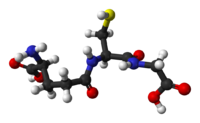
Photo from wikipedia
Phagocyte-derived production of a complex mixture of different oxidants is a major mechanism of the host defense against microbial intruders. On the protein level, a major target of these oxidants… Click to show full abstract
Phagocyte-derived production of a complex mixture of different oxidants is a major mechanism of the host defense against microbial intruders. On the protein level, a major target of these oxidants is the thiol group of the amino acid cysteine in proteins. Oxidation of thiol groups is a widespread regulatory post-translational protein modification. It is used by bacteria to respond to and to overcome oxidative stress. Numerous redox proteomic studies have shown that protein thiols in bacteria, such as Escherichia coli react towards a number of oxidants in specific ways. However, our knowledge about protein thiols in bacteria exposed to the complex mixture of oxidants encountered in the phagolysosome is still limited. In this study, we used a quantitative redox proteomic method (OxICAT) to assess the in vivo thiol oxidation status of phagocytized E. coli. The majority (65.5%) of identified proteins harbored thiols that were significantly oxidized (> 30%) upon phagocytosis. A substantial number of these proteins are from major metabolic pathways or are involved in cell detoxification and stress response, suggesting a systemic breakdown of the bacterial cysteine proteome in phagocytized bacteria. 16 of the oxidized proteins provide E. coli with a significant growth advantage in the presence of H2O2, when compared to deletion mutants lacking these proteins, and 11 were shown to be essential under these conditions.
Journal Title: Redox Biology
Year Published: 2019
Link to full text (if available)
Share on Social Media: Sign Up to like & get
recommendations!